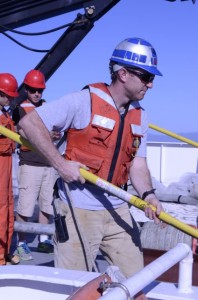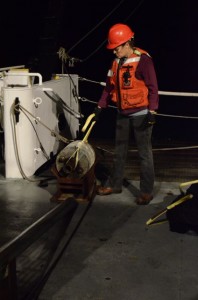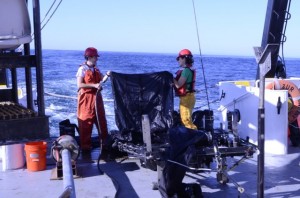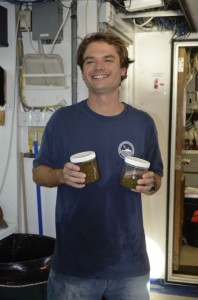This is the final post for the first cruise of the R/V Point Sur Chief Scientist Training, Workshop, please access the most recent Chief Scientist Workshop Cruise blog!
-
Recent Posts
Recent Comments
Archives
Categories
This is the final post for the first cruise of the R/V Point Sur Chief Scientist Training, Workshop, please access the most recent Chief Scientist Workshop Cruise blog!
Final sunrise on the way back into Moss Landing Harbor:

I think I can speak for the whole group when I say that this workshop and cruise were an incredible experience. In just two days, we learned the ropes of how to propose and plan for a research expedition, and over the next four got to carry one out. We had five major pieces of equipment out there – the multicorer (here and here), gravity corer, CTD, MOCNESS, and Tucker Trawl, each of which were deployed numerous times to collect samples for our own research projects. In addition to these, there were instruments that sample currents and surface properties (temperature, salinity, etc.) while underway. Challenges arose– the multicorer sometimes came up empty, the MOCNESS nets got all tangled up, we had trouble transferring data off of one of the CTD instruments.
But challenges are the reality of conducting ship-based science- and we learned how to troubleshoot at sea, adjust the schedule to make best use of time, and work closely with the captain and crew to keep science and navigation needs well-coordinated. Our captain, Rick Verlini, was an absolute pleasure to sail with. The marine technicians, Stian Alesandrini and Cambria Berger, oversaw all operations, and were brilliant at problem-solving and communicating between the bridge and the science party. The food was amazing and plentiful, and all the crew engaging and helpful. The Pt. Sur is a beautiful ship, well-laid out for science operations with a spacious lab, and a comfortable galley (dining area). Our Chief Scientist and mentor, Kenneth Coale, is a true joy to sail with- he shared with us his many experiences as a chief scientist, was always there to lend a hand with operations, and provide guidance on decisions. Co-chief scientists Amy Wagner and Ryan Rykaczewski did a great job coordinating the schedule and accommodating the various science activities. Not only did we form new friendships, as naturally happens when in such close space as on a ship, but we anticipate new and perhaps unexpected collaborations to arise from this experience.
The next group of participants shows up at the ship tonight, and will take over the blog tomorrow. Thanks for following us!


Stian hooking the MOCNESS. Cambria prepping the gravity corer.

Kenneth looking over the plan for the day.
Photo credits: Amanda Netburn
After a full day of sediment coring and me figuring out how to communicate with my instrumentation, we finally made it to the location offshore of Point Sur to observe the California Undercurrent. The undercurrent is a swift poleward flow, which is counter to the prevailing southward flow of the California Current, and carries warm, salty, and nutrient rich waters. The undercurrent doesn’t have a surface expression so using ships such as the R/V Pt. Sur is essential at observing it. The undercurrent resides at the shelf break between 1000-3500 m water column depth with maximum currents typically between 150-300 m depth. The undercurrent actually travels the whole western coastline with signatures of the current observed as far north as Alaska. We chose this particular transect based on previous studies by Curt Collins at the Naval Postgraduate School and proximity to Moss Landing.
To accompany the shipboard ADCP (instrument to measure upper ocean currents) we did CTD casts to measure the temperature, salinity, and oxygen of the water column at each end of the ~100 km transect and at the mean position of the core of the current in ~2500 m water column depth at the shelf break. At the beginning of the transect we started cruising from deep water offshore towards land perpendicular to the coast. When we arrived at the projected core location of the current we certainly didn’t see what we expected to see. We actually saw southward flow at the site according to the Shipboard ADCP. As we continued down the transect line we realized that we were in the midst of a large counter clockwise current system we call an eddy. Eddies are exciting features and are hard to predict when they will occur. It turns out the eddy was transporting a large plume of high chlorophyll water off shore from the headland of Monterey Bay. This frontal zone of high chlorophyll also prompted the use of the MOCNESS by Ryan to check out this front to the north of the transect line (see his blog post).
We ended the transect of the undercurrent near sunset with absolutely stunning weather. The winds were light and the seas were calm. A group of dolphins surfed the bow wake at the front of the boat and whales breached off in the distance as a group of us tried to spot the infamous green flash as the sun set over a cloudless sky.
Stu shows off his lowered ADCP (the yellow instrument), which he uses to measure ocean currents.
Collecting water from the CTD-mounted Niskin bottles.
photo credits: Top- Amanda Netburn, Bottom- Amy Wagner
by Ryan Rykaczewski
Nearly all of the food that nourishes ocean predators passes through zooplankton. These microscopic organisms are a critical link between the ocean’s primary producers (the phytoplankton) and the higher predators such as sharks, marine mammals, fish, seabirds, and turtles. Changes in the distribution of zooplankton in the ocean can impact the productivity of these higher trophic level organisms and influence the flow of carbon, nutrients, and energy through the marine ecosystem.
The survival of zooplankton in the ocean is dependent on a delicate balance of avoiding predators and finding food. Zooplankton find highest concentrations of their phytoplanktonic prey near the sunlit ocean surface. However, venturing into this upper part of the ocean water column exposes zooplankton to visual predators that are always on the lookout for a quick meal. In response to these contrasting pressures—the need to find food at the surface while also minimizing the likelihood of predation—zooplankton throughout the world’s oceans conduct a massive migration every dawn and dusk: typically rising towards the surface under the protection of darkness at dusk to find food and then descending to the dark ocean depths as the sun rises at dawn.
Mesoscale and submesoscale features (fronts, eddies, jets, and squirts) in ocean circulation are associated with vertical flow in the water column that create anomalies in food availability and predation risk for the ocean’s zooplankton. These anomalies act like loopholes in laws of ocean ecology and may supply zooplankton in the deep twilight zone with relatively nutritious, phytoplankton-rich waters. On the UNOLS Chief Scientist Training Cruise, I have been investigating how fronts formed by jets and squirts in the California Current affect the distribution of zooplankton and their interactions with their prey and predators. By using a plankton net known as the Multiple Opening/Closing Net and Environmental Sensing System (MOCNESS; or MOCNESS Monster by those who have grown familiar with its operation), I have been collecting zooplankton from various depths across submesoscale fronts. The MOCNESS comprises 10 nets that can be opened and closed in sequence. Although the MOCNESS Monster can be a handful to operate, it can provide valuable insight into the biological dynamics of ocean ecosystems. With the zooplankton samples collected with the MOCNESS, I intend to examine how composition and depth distribution of zooplankton are influenced by submesoscale circulation and shed some light on how these circulation features may influence predator-prey encounter rates in ocean ecosystems.


MOCNESS deployment. Amy and Amanda rinse down the 10 nets.

Ryan showing off his plankton samples.
Photo credits: (top left: Amy Wagner, top right: it’s a mystery, bottom: Amanda Netburn)
For a brief moment this evening, the whole gang of Chief Scientist Trainees was awake. Since operations run around the clock, such moments are rare. We saw humpback whales breaching in the distance (too far for my camera lens to get a good shot unfortunately), dolphins ride the bow wake, the Big Sur coast to the east, and the sunset to the west. It was a beautiful last evening on the water. I’m headed to bed after a 20 hour shift of net tows and CTD casts, but the ship remains busy with some nearshore coring operations which will go on until just before we arrive on land tomorrow.
Photo credit: Amanda Netburn
This is my first trip out on the Pacific, all my time has been spent in the Gulf of Mexico, and the sights leaving the dock could not be more different. Instead of alligators, shrimp trawls, and oil rigs I see otters, seals, and even whales in the background (my first whale encounter). My previous cruises have all been very focused with everyone working on one problem, getting mud from the bottom of the Gulf onto the boat and into jars. Seeing trawls and gravity cores is quite exciting. The first stations were mine, and problems of course arose on the first station. However, we managed to overcome them and get relatively good samples. My goal on the trip is to sample a few seeps, or areas where hydrocarbons such as methane reach the seafloor from deep underground. These areas are hotspots of biological activity as hydrocarbons are a source of energy for animals in an otherwise food limiting deep ocean. The hardest part of sampling a seep from the surface without a submersible is actually dropping your equipment in the right spot, as these seeps are often small. Ship positioning is never exact and when something is dropped over the side of the boat down several hundred meters it is rare that it drops straight down due to currents. So with much anticipation I waited on deck for the corer to come to the surface with my precious samples and hoped that there would be some sort of evidence that we had hit the mark. When the corer comes up I can see there is indeed mud contained within, and upon further inspection a notice small red shrimp, caprellid amphipods, and worm tubes on the surface of each core. Jackpot! While we may not have hit directly on top of the seep we are very likely in the vicinity as these shrimp are often associated with seeps, and the likelihood of capturing multiple shrimp in several different cores on bare deep seafloor are remote at best. Once the cores are back on deck I cut them into 3 different sections down to 10 cm in depth, as this is where all the animals are generally found. While processing the cores we notice some sort of precipitate in the mud, another hint that we may be close to a seep. I could not be more pleased. Due to the cost of sampling, no one has yet had a chance to look at the differences in animals within a seep. Generally studies can only afford to take one or two samples at a given location before moving to the next spot. This research may be able to better help people sample this environment in the future. We move on to stations 2 and 3, but difficulties with the corer prevent us from getting samples here. With any luck we will have time to go back to the original station, where the shrimp were found, to get more samples and further flesh out just how many differences are found within this very dynamic habitat. Until then I will enjoy helping the rest of the scientists with their research and learning how to use some very cool and different equipment as well as how to be a chief scientist.
Travis and Kenneth extruding the core sample.
(Photo credit: Amanda Netburn)
By Amy Wagner
So what do we (the scientists) do to entertain ourselves or remind us of our families at home during our “off” time at sea? Well, one of the things we can do is decorate Styrofoam® cups and send them down to great depths in the ocean.
We had a group of students from Knoxville Middle School in Knoxville, Iowa and Waukee South Middle School in Waukee, Iowa send us some cups they decorated so we could do exactly that. Below are some before and after shots of the cups. All we do is put them in a mesh laundry bag and attach the bags to the CTD rosette that gets lowered over the side of the ship. When they come back on board, they are about 50% smaller!
“Why does this happen?” you may ask. Styrofoam cups have a lot of air in them. When air is pressurized, it compresses. As you descend into the depths of the ocean, the pressure is immense. For every 10 meters you go into the ocean, an atmosphere’s worth of pressure is added. For example, if you dive down to 33 feet (10 meters), there is twice the air pressure than there is at the surface and at 330 feet (100 meters) the air pressure is 10 times that at the surface. Can you calculate what the pressure would be on these cups that are dropped down to 1000 meters?
Photos by: Amy Wagner
Styrofoam cups attached to CTD frame. Amanda Netburn with regular cup.
Tiny cups! Amy Wagner with shrunken cups.
Side by side comparison (photo by Amanda Netburn)
In the deep, cold, and dark open oceans of the world, a diverse group of fishes and other animals aggregate. These animals are strange looking- the fish are small, with big sharp teeth, and have lures and small spots on their bodies that produce light, there are bright-red shrimp-like animals, and many different kinds of jellies. These animals live in this seemingly inhospitable environment so that they can hide in the darkness from their predators. For the fish, these predators include sharks, tunas, and dolphins- animals we would worry about if they were to lose a major source of food. The depth of this midwater layer can change with location, time of day, time of year, and other factors, but is typically around 200-1000 meters (~600-3000 feet).
Off the coast of California, waters at these depths are extremely low in oxygen, and the amount of oxygen in the water is decreasing due to climate change impacts. The low oxygen layer here seems to limit the amount of habitat that the fishes have available to them, and they stay above the areas with super low levels of oxygen.
I am interested in finding out how the continued loss of oxygen in the deep ocean is going to affect the fishes that live there. Will there be less deep-sea fish there overall? Will the fish move to shallower water? Will some species leave the area to be replaced by more tolerant species? Will their energy demands change? How will these changes affect the animals that rely on them for food?
In order to answer some of these questions, I collect animals directly with midwater trawl nets, map their distributions with echosounders, and measure their metabolic activity in the lab. On this cruise, I am using a Tucker trawl to collect fishes for metabolic activity measurements.
Here are some of the cool critters that the net has brought up so far:
CRUSTACEANS:
FISHES:
CEPHALOPOD:
Octopus.
TUNICATES (relatives of seasquirts):

 Pyrosome on left, and salp on the right.
Pyrosome on left, and salp on the right.
Ask us in the comments, and one of us will get back to you ASAP.
Early on Friday morning (around 2 AM), our science team got our first
gravity core! This gadget is one of the most reliable tools for
collecting marine sediment from the bottom of the ocean. It is kind of
shaped like a long pipe, with a bunch of lead weight at the top, and
an empty 8-foot-long plastic tube in the middle of the pipe. The whole
thing weighs about 800 lbs., and when deployed correctly, the pipe
goes into the seafloor straight up and down, with the lead weight
providing enough mass to push the gravity core deep into the sediment.
After the ship uses its powerful winch to pull the gravity corer back
to the surface of the ocean, and we haul it back onboard, we remove
the plastic tube – which is now filled with a great sample of sediment
from over 6000 feet underwater!
I bet you are wondering what sediment is – this is all the solid stuff
that slowly settles out of ocean water to the seafloor, and includes
all sorts of things, like mud from rivers, dust from deserts, the tiny
bodies of plankton, sometimes even volcanic ash or rocks from
icebergs! Most of these things are too tiny to be seen by the naked
eye, so marine geologists use microscopes to magnify the sediment for
study.
Now, I bet you are wondering why anyone would want to collect marine
sediment. There are lots of reasons, but at least for my research
(Jason), I use chemistry to reconstruct past ocean conditions. The
sediment at the bottom of the gravity core may be over 1,000 years
old, while the sediment at the top is much younger, perhaps as old as
only 1 or 2 years. When we get back to land, I’ll take these cores
back to my lab at the US Geological Survey and study them for many
years to come. Who knows what exciting stories the ancient ocean has
to tell?
Jason with the gravity corer.
It takes a lot of hands to deploy the corer.
Bringing the corer back on deck. If you look closely, you can see mud at the bottom, where the instrument pushed into the sediments.
Amy and Ryan (on the left) adjust the schedule while Joe and Jason (Jason on the right) show off their core.